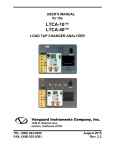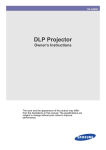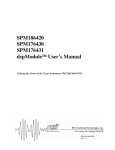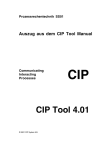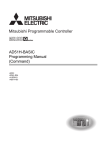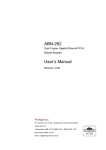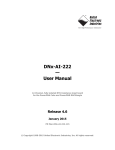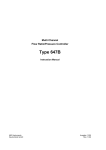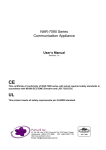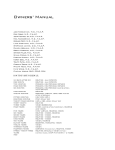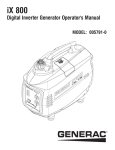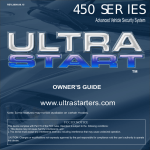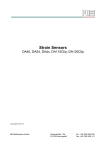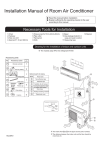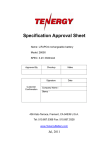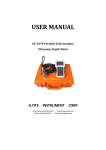Download USER`S MANUAL - Vital Systems
Transcript
AC SERVO DRIVE DSD SERIES USER’S MANUAL VITAL SYSTEMS INC http://www.vsys.co Precautions and Explanations ■Transport and storage ● Do not stack product package more than six layers; ● Do not climb, stand on or place heavy stuff on the product package; ● Do not pull the cable still connecting with machine to move product. ● Forbid impact and scratch on the panel and display; ● Prevent the product package from humidity, sun exposure, and rain. ■Wiring ● Ensure the persons involved into wiring and inspecting are specialized staff; ●Guarantee the product is grounded with less than 4Ω grounding resistance. Do not use neutral line (N) to substitute earth wire. ● Ensure grounding to be correct and solid, in order to avoid product failures or unexpected consequences; ● Connect the surge absorption diodes to the product in the required direction, otherwise, the product will be damaged; ● Ensure the power switch is OFF before inserting or removing plug, or disassembling chassis. ■Overhauling ● Ensure the power is OFF before overhauling or components replacement; ● Make sure to check failures after short circuit or overloading, and then restart the machine after troubleshooting. ● Do not allow to frequently connect and disconnect the power, and at least one minute interval between power-on and power-off. ■Maintenance Please implement routine inspection and regular check upon the following items, under the general usage conditions (i.e. environmental condition: daily average 30 ℃, load rate: 80%, and operating rate: 12 hours/ day) Routine Inspection (Regular Check): Confirm environmental temperature, humidity,dust, or foreign objects. Confirm abnormal vibration and noise; Check whether vents are blocked by yarn etc.. Routine(One year): Check whether solid components are loose . Confirm whether terminal block is damaged. ■ Guarantee period ● the guarantee period is 12 months(from the date of shipment).if it is broken under correct operation in guarantee period.we can promise give our customer repair for free. ● broken by the reason as below, customer need pay for the maintainance: 1.wrong operation and repair by customer themselves,retrofit induce driver broken. 2.broken by fire,water,abnormal voltage,other accident or twice accident induced device broken. 3.broken by human accident. 4.doesn’t operate base on our use mamual book. Anyother reasons,please contact us. Contents CHAPTER1 PRODUCT’S INSPECTION AND INFORMATION..........................................1 1.1 Product’s inspection............................................................................................................ 1 1.2 Product’s nameplate............................................................................................................ 1 1.3 Technical specifications of servo driver...............................................................................3 CHAPTERⅡ INSTALLMENT...............................................................................................5 2.1 SERVO DRIVER’S INSTALLMENT................................................................................5 2.1.1 Installing environmental conditions.......................................................................5 2.1.2 Use under harsh environments ..............................................................................5 2.1.3 Installation method ................................................................................................5 2.1.4 Multi- drivers install ..............................................................................................6 2.2 Servo motor’s install ...........................................................................................................6 2.3 Notice of installment...........................................................................................................6 2.4 Motor rotation direction definition.....................................................................................6 CHAPTER III WIRING ..........................................................................................................8 3.1 Wiring requirement.............................................................................................................8 3.1.1 Driver terminal.......................................................................................................8 3.1.2 Wire specification..................................................................................................9 3.2 Motor and power’s wiring diagram....................................................................................9 3.2.1 wiring diagram......................................................................................................9 3.3 Power line terminal even chart .........................................................................................10 3.4 CN1 Signal controller terminals .......................................................................................10 3.4.1 Terminal arrangement...........................................................................................10 3.2.2 Terminal name and function ............................................................................... 11 3.5 CN2 encoder Terminal......................................................................................................12 3.5.1 Terminal arrangement...........................................................................................12 3.5.2 Terminal definition...............................................................................................12 3.6 CN3 Computer communication terminals ........................................................................13 3.7 whole wiring diagrams......................................................................................................13 3.8 Principles of input and output interfaces ..........................................................................16 3.8.1 EN, MODE, INTH, CW, and CCW Switch Input Interface................................ 16 3.8.2 SRDY, ALM, BRAKE, COIN, and OZ Switch Output Interface .......................16 3.8.3 Pulse Signal Input Interface: ...............................................................................17 CHAPTER IV DISPLAY AND PARAMETER SETTINGS .................................................19 4.1 Servo System panel...........................................................................................................19 4.2 Keyboard Operation..........................................................................................................19 4.3 Parameter Settings ............................................................................................................20 4.3.1 Password input and changes...................................................................................21 4.3.2 Parameter settings...................................................................................................21 4.3.3 Parameter writing....................................................................................................22 4.3.4 Parameter initialization...........................................................................................22 CHAPTER V PARAMETERS .................................................................................................23 Chapter VI Operation JOG Control of Servo System...................................................................................................33 Position Control of Servo System ............................................................................................33 Speed Control of Servo System.................................................................................................34 Torque Control of Servo System................................................................................................34 Internal Speed Control Servo System........................................................................................ 35 Internal Four Section Position control servo system .................................................................35 CHAPTER VII ERROR ALARM .............................................................................................36 CHAPTER VIII DEBUGGING ................................................................................................38 8.1Working sequence.................................................................................................................38 8.1.2Sequenceof connected power ............................................................................................38 8.1.3 Sequence of servo off .......................................................................................................38 8.2 Usage of Mechanical Brake “ BRAKE” ......................................................................39 8.3 Debugging ...........................................................................................................................39 CHAPTER 1 PRODUCT’S INSPECTION AND INFORMATION 1.1 Product’s inspection The product’s function and stability has been tested before shipment, for avoid someabnormal oversight accident induce the problem happen in transportation, pls check the itemas below: Pls confirm if the product’s model number and make sure it is the model you want. Compare the product list and see if accessories integrity and not been broken Check the appearance of motor and driver, if it is damage by the transportation, do notelectrify. Inspection if any parts fall off. Inspect the axis of the motor can rolling by hand smoothly.Note motor with break can’t be roll without external breaking power . If any abnormal happen as describe above,pls contact us as soon as possible. 1.2 Product,s nameplate DSD20 :DS—denver servo ,D—driver,20—20A 1.3 Technical specifications of servo driver Base specific ation control technique Three phase full-wave rectification SVPWM Space Vector cotrol Powe input AC220V -15%~10% reaction Use condition 2500-line incremental photoelectric encoder use/Storage 45℃/-40℃~55℃ temperature use/Storage 40%~80%/90%(non condensing) humidity degrees Protection level IP10 Vibration 4.9m/s2/19.6 m/s2 resistance/ inpact resistance Position mode Input signal sea level elevation <1000m,1000m reduce rate voltage Atm press 86~106kpa Comm and inpulse Pulse 1. 2. 3. 1. form 2. collector open circuit Impulse frequency 1. Differential drive:500K Impulse various inpulse+direction inpulse+inpulse A+B 90°Orthogonal pulse Differential drive 2. collector open circuit:200K Speed Simulation command input -10V~10V input impedanc 10kΩ mode Command +/-speed Instructions percentage Parameter setting Instructions source Simulation External analogue Internal speed instructions Parameter setting Torque Simulation command input -10V~10V input impedanc 10kΩ mode Command +/-speed Instructions percentage Parameter setting Instructions source Simulation External analogue Internal speed instructions Pulse output signal Encoder I/O signal Parameter setting A,B,Z differ act output Zsignal corrector output Input signal Servo EN,ACLR,Position banned,Are turning the limit,Reversal limit, conrol mode. Built in Output signal Positioning complete,Servo alarm,servo ready,break output,zero point output. Defencive function Overcurrent,overvoltage,low Function voltage,overload,over s speed,encoder heat,lack phase,over abnormal,outoftolerance,mode abnormal alarm etc. Surveillance Function Rotate speed,current pulse,frequency,positional location,current deviation,Motor torque,Motor curren,Analog input values, etc. Other characte ri stics Communication function 6 point LED display Speed regulation ratio 1:5000 Speed fluctuation rate <±0.03%(Rated load in) CHAPTERⅡ INSTALLMENT 2.1 SERVO DRIVER’S INSTALLMENT 2.1.1 Installing environmental conditions The install environment has directly effect of driver’s function and service life;so it must be installed under condition as below: 1. Working temperature:0~45℃;Work environment humidity;lower than 40%~80% (non condensing ). 2. Storage environment temperature:40~55 ℃ ;Storage environment humidity:lower than 90% (non condensing ). 3. vibrate: lower than 0.5G. 4. To prevent the rain drops of rain or moist environment. 5. Avoid direct sunlight. 6. Prevent oil mist,erosion of salt. 7. Prevent corrosive liquid,gas. 8. Prevent dust,cotton fibre And metal scraps into thin. 9. Far from radioactive substances and flammable objects. 10. Many driver install in one box.pls remain enough space between each driver.it is better for flow of air to help heat dissipation.Please plus the configuration of the fan.make sure the temperature not too high.The safe temperature is 45℃. 11. Near a vibration sources,pls add a vibration absorber or vibration rubber gaskets if can not avoid the vibration. 12. Jamming equipment around the servo drive will produce interference, resulted in false operation. Noise filter and other anti-jamming measures can be used to guarantee drive to operate normally. Please note that leakage current will increase after noise filter added. To avoid the above situation, isolation transformer can be adopted. Please pay special attention that reasonable wring and shielding measures can prevent drive control signal from interference. 2.1.2 Use under harsh environments When used in harsh environments, servo drive will contact with corrosive gases, moisture,metal dust, water and processing liquids, which shall bring the malfunctions. Therefore, noise filter and other anti-interference measures should be taken to ensure the drive to work normally.Please note that leakage current will be increased after installed noise filter. In order to avoid theabove situation, you can select isolation transformer, in particular, control signal lines of drive are easy to be interfered and reasonable wiring and shielding measures should be considered. 2.1.3 Installation method ● Installation direction: the direction of the normal installation is vertical upright orientation. ● Fixing: 4 pieces M5 screw on servo drive should be fixed. ● Ventilation and cooling: natural cooling mode is adopted. Cooling fan should be installed in the electric control cabinet. 2.1.4 Multi- drivers install 2.2 Servo motor’s install ● Working environment temperature:0~45℃.Work environment humidity,lower than 40%~80% (non condensing ). ● Storage environment temperature:40~55℃£?Storage environment humidity,lower than 80% (non condensing ). ● vibrate: lower than 0.5G. ● Avoid direct sunlight. ● Prevent oil mist,erosion of salt. ● Prevent corrosive liquid,gas. 2.3 Notice of installment Do not hit motor or motor shaft while disassembling pulley, in order to prevent encoder from damage; use spiral drawing tools for disassembly;Prohibit large axial and radial load on motor; suggest to select flexible coupling to connect the load;Fix motor with washer fastening to prevent the motor from loosing. 2.4 Motor rotation direction definition Face motor’s shaft extension,counterclockwise rotation direction is foreward,clockwise rotation direction is inversion.The driver’s num 39 parameter can change the motor’s rotate direction, According to the situation to change the direction. Chapter III Wiring 3.1 Wiring requirement ● Use correct wire material according to the wire use specification, ● Cable Length .Instructions cable , less than 3m,encoder wire must less than10m. ● Check R,S,T power box wire connecting correct or not,do not connect with 380V power source; ● Motor U,V,W connector,much match motor’s relevant connector, wrong connect will induce motor stop or damage; ● Must be reliable grounding.And the single point grounding. ● Avoid wrong motion by noise,pls add insulating transformer in the power source and noise prevent device. ●Signal wire keep distance more than 30cm to match power wire(power line/motor line ), do no put them in same wiring tube. ● Pls install using type circuit breaker make sure driver can cutting down power in emergency situation. ● Pls install Surge absorption components to match circuit’s Perceptual component, DC coil reverse in parallel fly-wheel diode, AC coil in parallel with Resistance and capacitance absorption loop. 3.2 Motor and power’s wiring diagram Mark R S T Signal Name Signal function Three-phase or single-phase main power AC220V 50HZ , Can not be connected with the motor UVW. Servo Motor UVW-one correspondence with the motor must be connected to Grouding Then motor shell U V W PE 3.3 Signal controller terminals PIN Signal Name Mark I/O Signal function 1 Position completed COIN+ output ① Positioning complete output,when the position deviation is less than the range set out in force ② End of output within the pulse is running efficiently. ③ The percentage of the output torque to reach P46 z Parameter P2 set up this feature 2 Servo alarm ALM+ output Servo alarm output valid 3 Ready output SRDY+ output Servo ready for trouble-free alarm output valid 4 Brake signal+ BRAKE+ output 14 Brake signal- BRAKE- output 15 Positive input signal power 7 8 9 Servo Enable Command pulse and alarm clear signal to prohibit Forward limit INCOM+ SON INTH CWL CCWL After Servo is enable ,brake signal is effective. input Input terminals of the power used to drive the positive input terminals of the optocoupler DC12~24V,current>=100mA input Servo enable input terminals SON On:Allowing the drive to work SON Off : Drive off,stop working .Motor in a free state. Could be located P6=1 mask this feature. input Position command pulse input terminals to prohibit,the parameterP49=0 、 1 、 2 to set this ferture. 0:Invalid,does not detect the signal INTH. 1:Detection INTH signal effective 2:Test INTH effective and to remove the remaining. input Motor Forward limit input signal, the parameter P48=1 configure this feature,P48=2 is not warning. input Motor Reverse limit input signal, the parameter P48=1 configure this feature,P48=2 is not warning. ① 位置和速度功能选择,有效时选择速 度控制 ② 内部速度选择,有效时选择内部速度 ③ 内部脉冲方式启动信号 10 Reverse limit 12 Control method or function selection MODE input 13 Analog GND Vgnd input 11 Analog input Vin input 16 Pulse signal- PULSE- input 17 Pulse signal+ PULSE+ 18 Direction signal- DIR- 19 Direction signal+ DIR+ 5 Encoder Signal Z OZ+ output Open-collector output ,to end the OUTCOM 20 Encoder signal Z+ PZ+ output Z motor encoder signal output External speed or torque command: 0~±10V External position control command, parameter setting mode P34. 0:Pulse+Sign pulse plus direction input 1:CW+CCW positive,inversion of control input 2:A+B 90°quadrature pulse input 21 Encoder signal Z- PZ- output 22 Encoder signal B+ PB+ output 23 Encoder signal B- PB- output 24 Encoder signal A+ PA+ output 25 Encoder signal A- PA- output B motor encoder signal output A motor encoder signal output 3.5 CN2 encoder Terminal PIN Name Description PIN Name Description 2 A+ PG input A+ 8 U+ PG input U+ 3 A- PG input A- 9 U- PG input U- 4 B+ PG input B+ 10 V+ PG input V+ 5 B- PG input B- 11 V- PG input V- 6 Z+ PG input Z+ 12 W+ PG input W+ 7 C- PG input Z- 13 W- PG input W- 1 5V PG power +5V 14 0V PG power 0V 3.7 whole wiring diagrams 3.8 Principles of input and output interfaces 3.8.1 EN, MODE, INTH, CW, and CCW Switch Input Interface 1.by the user to provide power , DC 12V-24V,current >=100mA. 2. Please note the reversed current polarity will cause servo drive to fail to work properly. 3.8.2 SRDY, ALM, BRAKE, COIN, and OZ Switch Output Interface 1. OZ, SRDY, COIN,and ALM signal maximum current is 20mA;BRAKE signalmaximum current is 50mA; 2. Output is open collector form. 3. please note the reversed current polarity will lead servo drive to be damaged. Switch output Interface. 3.8.3 Pulse Signal Input Interface: Pulse signal input interface of the differential drive mode: 1.requiredpulse frequency ≤ 500 kHz.Duty cycle is 1:1,and actual demand isto be required to pass 0.4US. 2. adopting differential drive mode . 3.AM26LS31,MC3487 or similar RS422 line drivers should Pulse signal input interface of the differential drive mode: be used. Pulse signal single-ended input(Applicated to PLC upper monitor and so on.) ●usually used as PLC pulse control voltage Resisstance value R(reference value): 24V:2KΩ 12V:1KΩ 5V:100Ω ●driver current 10~15mA. ●noted do not connect in reverse for polar of porwer ●pulsefrequency ≤200KHz. ●the connection is used as Mitsubishi PLC . Pulse signal single-ended input mode Pulse Input Modes Pulse command P34 settings PULS Pulse + sign 0 SIGN CCW Pulse CW Pulse PULS 1 SIGN PULS A + B Puls 2 SIGN Pulse Input Timing Parameters Parameter Differential Driver Input Single-ended driven input tck >2uS >5uS th >1uS >2.5uS tl >1uS >2.5uS trh <0.2uS <0.3uS trl <0.2uS <0.3uS ts >1uS >2.5uS tqck >8uS >10uS tqh >4uS >5uS tql >4uS >5uS tqrh <0.2uS <0.3uS tqrl <0.2uS <0.3uS tqs >1uS >2.5uS Pulse + Sign Input Interface Timing Diagram (Pulse Frequency ≤ 500kHz) CW + CCW Pulse Input Interface Timing Diagram (Pulse Frequency ≤ 500kHz) Chapter IV Display and Parameter Settings 4.1 Servo System panel Servo System panel comprises 6 LED digital tube displays and 4 keys. Digital tube is used to show the various states and parameters of servo drive; key is used to set and access system parameters. 4.2 Keyboard Operation Drive panel comprises 6 LED digital tube displays and four keys “DEC”,INC”, “M”,“S”to display various states of the system and set parameters.Key features are as follows: “DEC”:oparameter number, value increase, or motor running forward under the JOG mode; “INC”:oparameter number, value reduction, or motor running reversely under the JOG mode; “M”:function options, or the current digital cursor moving left. “S”:function key for confirmation, or data entry confirmation. Under normal circumstances, press "M" to entry ① "parameters" setting, ② "parameter written", ③ “Display state”, all of which can be cycle selected. ①"Parameter": P1--P68 ②"Parameter writing": It is valid when entering right password; ③ "Display state": Same as indicated content of P3 parameter The servo system is normally displayed with the following 11 methods: 1.display motor rotation speed :parameter P3=0,unit r/min 2.display motor current :parameter P3=1,unit A. 3.display motor torque percent:parameter P3=2,unit Nm 4.display position : parameter P3=3,unit pulse 5.display position deviate :parameter P3=4,unit pulse 6.display frequency of the input pulse: parameter P3=4,unit KHz 7.input pulse 4-bit lower:parameter P3=6,unit pulse 8.input pulse 4-bit higher:parameter P3=7,unit x10000pulse 9.Indicating motor operation position 4-bit lower:parameter P3=8,unit pulse 10.Indicating motor operation position 4-bit higher:parameter P3=9,unit pulse 11. display speed of motor: parameter P3=9,unit mm/min When password of input system fails to be found, you can access P3 "parameters" view, and enter password to modify P3 parameter; however, other parameters cannot be changed. 4.3 Parameter Settings ●Parameter P1 is input to display “0”; at this situation, “Enter” key can be pressed directly to indicate that system password has been input. 4.3.1 Password input and changes 1. Password must be entered into the system for system parameter setting of each boot.P1 parameter input is system password input. When the input password is correct, it can set other parameters; otherwise other parameters cannot be set. 2. Password is ‘1’. 4.3.2 Parameter settings 1 Under normal circumstances, press "M" to entry ①"Parameters". 2.Press " INC " or " DEC " keys to select the parameters number which you want to modify, and then press "S". 3)Press " INC " to auto-add one value, press " DEC " key to auto reduce one value, and press "M" key to shift current the current number(decimal point position) to the left, and press "S" key for data confirmation. 4.3.3 Parameter writing: 1.In the display status, press "M" and select to enter "parameter writing" parameter writable state, When changed parameters by user need to save for long term, parameter writing operation should be implemented. 2. Press "S" key for three seconds, and the parameters will be written in the internal EEPROM. 3.then press "S" key to return, after writing completion and showing. Chapter V Parameters Personnel involved into parameter adjustment must understand the meaning of parameters,for the wrong settings may cause equipment damage and personnel injury;It is suggested that all the parameters adjustment should be under the situation of the servo motor stationary. Parameter List: No. P1 P2 P3 P4 P5 Parameter Name Parameter password Fuction Description Parameter range Guard against mistaken or ill-purposed change of parameter. The password is 1. 1:Motor model is 60-01330 400W 2:Motor model is 80-02430 750W 3:Motor model is 80-04025 1KW 4:Motor model is 110-04030 1.2KW 5:Motor model is 110-05030 1.5KW 6:Motor model is 110-06030 1.8KW Motor model 7:Motor model is 130-04025 1KW 8:Motor model is 130-05025 1.3KW 9:Motor model is 130-06025 1.5KW 10:Motor model is 130-07725 2KW 11:Motor model is 130-10025 2.6KW 12:Motor model is 130-15015 2.3KW 0 : display motor rotation speed (r/min) 1:display motor current (A) 2:display motor torque percent (NM) 3:display position (pulse) 4:display position deviate (pulse) 5:display frequency of the input pulse First display (kHz) status 6:input pulse 4-bit lower (pulse) 7:input pulse 4-bit higher (pulse) 8:Indicating motor operation position 4-bit lower (pulse) 9:Indicating motor operation position 4-bit high(pulse) 10:display speed of motor (mm/min) 1 : Display alarm number and put Display alarm “UP”to display ather alarm number. number 2:clear alarm number. 3:Search moto origin. 1:resume system default parameter, and save to the EEPROM.After saved, display the End. Factory Default 1 1~12 1 0~10 0 0~3 0 0~3 0 2:Auto revise the current of V and W,and autosave to P17 and P18 parameter. 3:Auto revise the voltage of V and W,and autosave to P19 parameter. P6 Set SRV-ON disable 0:Enable 1 : Disable , won’t examine SRV-ON input signal. 0~1 1 0~7 0 0~30000 420 0~30000 0 0~100 80 0~30000 1600 0:Position control mode 1: Speed mode: external analog voltage P7 Select mode control P8 Current loop proportion gain P9 Current loop integral gain P10 Current loop output max P11 Speed loop proportion gain input 2:Torque mode: external analog voltage input 3:JOG mode: key control 4 : Torque and speed mode: MODE control. 5: 4 sections speed control. 6:16 sections speed control. 7: inner pulse contol inner startup. ① As this is bigger , response is more rapid,and easy to produce vibration . ②Commonly set to be zero except very high response frequency is needed. ①The value is bigger, response is more rapid,and easy to produce vibration. ② the load is bigger,and the value is smaller. To restrict current loop output max value. Set proportional gain of speed loop regulator;Bigger in its set value, bigger in gain and rigidity; the parameter value can be determined upon the specific servo drive model and loading situation. Generally, bigger in load inertia, bigger in its set value;It can be possibly set to be bigger under the situation of system without vibration. Set integral time constant for speed loop regulator; Bigger in its set value, faster in integral speed, and stronger in system deviation resistance, i.e. bigger in rigidity; However, too big value will produce overshooting.It can be possibly set to be smaller under the situation of system without vibration. 1:0.1V voltage.Used for speed control or torque control of the 0V voltage regulator. Set the proportional gain for position loop regulator;Bigger in set value, higher in gain and rigidity. Under the condition of identical frequency command pulse,position lag will be smaller; however, too big value will lead vibration and over-regulation of system; The principle of debugging is to possibly adjust this parameter to be bigger, under the situation of guaranteeing the system to operate without vibration nand jetter. The value is bigger,the position Deviation is smaller.Commonly, the value is zero. P12 Speed loop integral gain P13 Analog voltage input zero-bias P14 Position loop proportion gain P15 Position loop feed- forward P16 Speed loop feedback filter time P17 The value of Iv zero-bias Save The value of Iv zero-bias. P18 The value of Iw zero-bias Save The value of Iw zero-bias. The P19 P20 P21 value of external analog voltage zero-bias Current loop feedback filter time JOG,speed,and torque control acceleration and reduce time 0~30000 100 0~100 5 0~30000 740 0~30000 0 0-256 8 Save the value of external analog voltage zero-bias. P5=3,and auto get the value。 8 As this is bigger , speed response is more rapid and reduse is bigger. 0~30000 200 P22 Fix position control acceleration and reduce time P23 Position order pulse numerator 1 P24 Position order pulse denominator P25 preparation P26 Power alarm P27 Moto current rated P28 Moto speed rated P29 Speed output torque loop max P30 Encode number P31 Servo motor’s pole number Please look the motor manual book P32 Motor mode 0:U、V、W signal 1:No U、V、W signal 0~1 0 P33 Check overspeed alarm 0 : alarm is effective,over rated speed 10% 1:alarm is invalid. 0~1 0 0~2 0 -3000~ 3000 100 0~1 0 0~1 0 vatage encode mode As this is bigger , speed response is more rapid and reduse is bigger. ① Motor’s pulse number per rotate =10000x numerator / denominator ② Electronic gear G= numerator / denominator 1/30000<G<30000 0:alarm is effective. 1:alarm is invalid. For overcurrent protect.1=0.1A Restrict position loop output,and overspeed alarm max Restrict speed loop overloading protect and output 10 1~30000 1 1~30000 1 0~1 0 0~300 40 0~6000 r/min 3000 0~130 60 2500 0:Pulse+Sign 1:CW+CCW 2:A+B 90° P34 Pulse P35 JOG speed value P36 Search origin. P37 Moto encoder origin Storage moto encoder origin P38 Check encode signal alarm 0:Enable 1 : Disable , don’t signal input moto 0~30000 JOG speed P36=1 the same to P4=3. check encode 4 P39 Reverse speed order direction 0:No change ,in position and speed control 1 : Reverse ,in position and speed control 2: Speed and torque control direction by CW/CCW 0~2 0 P40 Drive overload alarm percentage Moto rated torque load exceeds the percentage of P27 ,alarm ER0-12. 1~300% 200 P41 Orientation finish range As difference count isn’t larger than this value , orientation will be complete. 0~30000 3 P42 Position control of the ultra-poor alarm 0:alarm is effective. 1:alarm is invalid. 0~1 0 P43 Location-toler ance detection range of As difference count is larger than this value ,alarm of positioning will produce 0~30000 3000 P44 preparation P45 preparation P46 preparation P47 Encoder lines sub-frequency Encoder output A,B sub-frequency signal must be an even number. 0~127 0 Settint CW、CCW 0 : Invalid,does not detect CW,CCW signals 1:Detection CW,CCW signals,CW and effective when the motor is transferred limit,CCW valid motor reversal limit ,and alarm. 2 : Detection CW,CCW is not valid alarm ,but motor stops running. 0~2 0 0:Enable 1:Disable , won ’ t check INTH signal input 2:Enable and Clear remain pulse Notice : clear alarm. 0~2 0 P48 limit P49 Set the servo input signal is valid INTH P50 preparation P51 Preparation P52 Internal value 1 P53 Internal value 2 P54 Internal value 3 P55 Internal value 4 P56 Internal value 5 P57 Internal value 6 P58 Internal value 7 P59 Internal value 8 P60 Internal value 9 P61 Internal value 10 P62 Internal value 11 P63 Internal value 12 P64 Internal value 13 P65 Internal value 14 P66 Internal value 15 P67 Internal value 16 P68 IPM current model DSD20set to 18,DSD30 set to 28 20 Chapter VI Operation After completion of the installation and connection, please check the following items before power-on: Whether the power terminal wiring is correct and reliable? Whether the input voltage is correct. Whether power lines and motor wires get short circuit or grounding.Whether the control signal terminal is connected correctly? Whether power supply polarity and size are correct.Whether drive and the motor are fixed firmly. Whether motor shaft is not connected to the load. Whether specification of motor and driver are matching. 6.1 JOG Control of Servo System When the system parameter is set to be P7= 3 and inner enable (P6=1), the servo system is under the mode of JOG control. Press "UP", servo motor rotates forward; Key-up the motor stops. Running speed is determined by the setting values of parameters P35. Press "DOWN" servo motor rotates reversely; Key-up the motor stops. Running speed is determined bythe setting values of parameters P35. JOG control acceleration and deceleration time constant is adjusted through parameters P21. 6.2 Position Control of Servo System When the system parameters are set to be P7 =0, servo system in under position control mode. Running speed is determined by input pulse frequency; running direction is determined by the input direction and P39; running pulse mode is set by P34.When P49 = 1, 2, and INTH signal is valid, this function can be terminated. Electronic gear is determined by P23 and P24. 6.3 Speed Control of Servo System When the system parameters are set to be P7 =1, servo system is in the speed control mode. The maximum operating speed is determined by the parameters P28. The maximum operating speed refers to the operating speed when input voltage is 10V. Operating speed is determined by Vin1 voltage, and direction is determined by the symbols of Vin 1 and P39. When P39=2, direction is determined by CW and CCW, wherein, CW and CCW respectively refer to motor rotation forward and reversely. Zero-drift of speed control is adjusted through parameter P13, and adjusting this parameter to set motor speed to be 0 when input voltage is 0V. Speed control acceleration and deceleration time constant is adjusted through the parameter P21. 6.4 Torque Control of Servo System When P7 = 2, Inner enable (P6=1), servo system is in torque control mode. Torque is determined by the input voltage Vin1. The direction is determined by the symbols of Vin1and P39. Input voltage is maximum torque when the torque is 10V. Zero-drift of torque control is adjusted through the parameter P13, and adjusting this parameter to set motor speed to be 0 when input voltage is 0V. 6.5 Internal Speed Control Servo System When the system parameter is set to be P7= 5, servo system is in the internal speed control mode. After the input signal MODE (level signal) is input and valid, the motor starts; after the input signal INTH (NC signal) is input and effective, the motor stops. Speed is determined by the input signals CW and CCW decision. Please see the below table: MODE signal CCW signal CW signal Motor speed 0 1 0 0 P52 1 0 1 P53 1 1 0 P54 1 1 1 P55 Chapter VII Error Alarm Do not touch drive and motor within 5 minutes after driver and motor power-off, to prevent person from injury due to electric shock;Allow to use drive after drive alarm code troubleshooting while drive failure alarms; Show Er0-xx and blinking while error is found, wherein xx refers to alarm code;Operate drive to view and modify parameters after alarming. Alarm List: Alarm Code Alarm Content Cause of the malfunction ER0-00 Normal ER0-01 Motor speed is too high 1.Encoder wiring error 2.Encoder damage 3.Running too fast ER0-02 The main circuit supply voltage is too high 1.The supply voltage is too high(more than +20%) 2.The circuit board failure ER0-03 Power supply votage is too low ① Servo system doesn’t connect with power ② Insurance ruins ER0-04 Position error too big ① ② ③ ④ ⑤ ER0-05 Drive temperature is too high ER0-06 EEPROM error ER0-07 CW motor forward limit The CWSTP switch be bumped ER0-08 CCW motor reverse limit The CCWSTP switch be bumped ER0-09 Encode trouble 1.Encoder damage 2.Encoder wiring is damaged or broken 3.P38=1 mask this feature ,you will not alarm ER0-10 overcurrent alarm 1.More than 300% rated current 2.Circuit board fault 3.overload ER0-11 IPM module fault 1.Electrical lines U,V,W short-circuit 2.overcurrent 3.motor is damage 4.Gai parameter is set incorrectly Machine is block input pulse frequency is too high Encoder zero change in P43 parameter setting is too small P42 mask this feature ,will not alarm Memory UVW 5.module is damage ER0-12 Motor alarm overload ER0-13 Soft IPM module fault ER0-14 Encode trouble ABZ Motor rated torque carried more than the percentage of parameter P40 1.Encoder damage 2.Encoder wiring is damaged or broken 3.P38=1 mask this feature ,you will not alarm Chapter VIII Debugging Motor and driver must connect to GND, PE must connect GND with Motor.Suggestions power drive provide by the isolated transformer for safely and anti-interference.Before power on, check all of connected wire are correctly.After driver fault alarm, confirm if fault are settled before re-start.Don’t touch motor and driver within 5 munities after power off for prevent shock. It may high temperature after motor & driver running a long time for prevent burns. 8.1 Working sequence 8.1.2 Sequence of connected power ● When connect control power, servo driver alarms within 400ms; when main power is on,the alarm disappear, servo motor prepare signal ON within 1.5s, internal servo’s enable become effective, the motor excitation is on within 10ms. 8.1.3 Sequence of servo off Alarm sequence during motor’s running: SRDY signal and servo enable signal are ineffective at the same time, and the motor’s electromagnetic brake signal is off 4ms later. 8.2 Usage of Mechanical Brake “ BRAKE” Mechanical brake is used to lock the vertical or tilt table connecting motor, to prevent motor from falling down after power-failure. The motor with brake feature should be selected to achieve this function. This brake can only be used for keep the table, not for motor’s deceleration or machine’s stop. After connecting with the required voltage, the internal brake will open, and the motor bearings can rotate freely. Using Driver BRAKE signal control intermediate relay, which is start braking power by intermediate relay (Braking power provide by user). When install the signal, brake power must have enough capacity, then it must use free-wheeling diode as surge absorber. 8.3 Debugging Before power on, it must check the correctness of the parametersIncorrect parameter setting will may caused machine fault and accident Suggestion no-load debugging firstly, then load debugging. 8.3.1 Adjustment of gain and rigidity The servo system applies feedback system of PID adjustment, current loop, speed loop and position loop. The rule it obeys is: the inside of the ring, the need to improve its ability of response. Or it will appear over-adjust or vibration. As the current loop is enough to ensure itsability of response, usually it doesn’t need to change. What should be adjusted are position loop and speed loop. The servo adjustment of position mode as below: ● Set a relative high value of speed loop integral; ● Set a relative low value of position loop gain, then begin to add the speed if there is novibration or abnormal noise; ● Adjust the value of speed loop integral to smaller if there is no vibration; ● Add the position loop gain until there is no vibration; ● If the electronic gear ratio is bigger, please adjust the value of P18 to make motors run at quiet; Knowledge of mechanical system’s rigidity: ● If the rigidity of the conveyors connected by belt is low, please use low rigidity parameter; ● If the rigidity of the ball screw drove by gear box is medium, please use medium rigidity parameter; ● If the rigidity of ball screw drove by servo motor is high, please use high rigidity parameter.The adjustment of servo depends on the system, which needs your careful watching, thinking,then you can find suitable parameters.
































